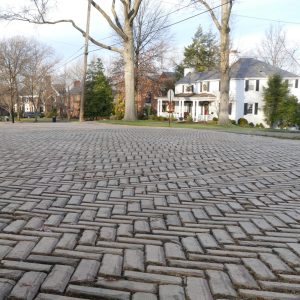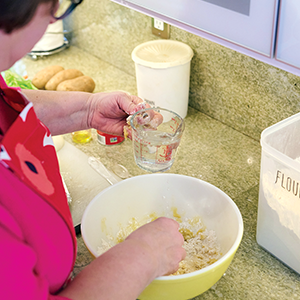It’s Not About Ricotta
No one likes to have to scroll to the end of a recipe blog. If you’re here for my Western Pennsylvania-ized Italian recipes, by all means, skip my rambling. Click here for the sauce, here for the lasagna, here for the stuffed shells and here for my note about manicotti.
Let me preface this by saying I’m not Italian, and I’m not pretending to be. I’ve actually never known much about my cultural makeup. However, I did get my twin brother an Ancestry DNA kit for Christmas one year and it revealed what I already suspected—we’re 81 percent English and German and our DNA shows that we descended from a group of early Pennsylvania settlers. These ancestors presumably immigrated here so long ago that my family never really retained any traditions or recipes from those countries.
Perhaps because of this, I’ve always been jealous of people who have them, and I’m a bit over-enthusiastic about some of those “cultural” foods that have worked their way into the fabric of our western Pennsylvania culture. (See my blog about my favorite food, pierogies).
I’m writing this blog today because I’ve observed something peculiar about what one side of my family—and, I’ve noticed, some others in the region—sometimes do to Italian food: We opt to eliminate or reduce the amount of ricotta in Italian dishes where ricotta is usually the star of the show. I love ricotta, but all of my grandma’s “Italian” food recipes (that really aren’t Italian at all) are designed this way. And, in my humble opinion, they’re still excellent in their own way. Scroll down to see what I mean.
But first, a bit about my grandma. At this moment in time, she’s living with dementia. I’m lucky, in my 31st year of life, to still have her and my Pap. I also feel fortunate that, for all of my childhood and a lot of my adulthood, I have vibrant memories of what my grandma was like before her diagnosis. Some of my favorite memories took place in her kitchen in Northern Cambria, Pennsylvania (formerly Barnesboro), where my mother was raised and my family would often gather for the holidays: my dad and I sneaking scraps off a Thanksgiving turkey as it rests before carving, breaking out the old Super Nintendo and playing Donkey Kong Country with my cousins, my mouth watering as my grandma pulls an enormous black-and-white speckled enamel roaster out of the oven, knowing that, whatever the contents, I’ll be dreaming about this meal for a long time to come. Because, boy, could she cook.
My good fortune continues on my dad’s side of the family, as my soon-to-be-94-year-old Gram is alive and well. Also from Northern Cambria (and also an excellent cook. Now, I’m thinking about her chicken and waffles … ), she remembers when immigrants from Italy first started settling in the town. She remembers her first slice of pizza, her first taste of spaghetti. And she’ll tell you all about the Mount Carmel church festival and how the Italian families added their own customs—like parading through the streets with a statue of the Virgin Mary, which people would pin dollars to—making one of the town’s largest festivals of the year even that much more special.
Our Lady of Mount Carmel Church has long since closed, along with the coal mine that was at the center of the town’s economy. And now, all of my grandparents have moved to Indiana, Pennsylvania, where my parents live and where I was raised.
So here, at the end of the long-winded recipe blog that I promised myself wouldn’t be long-winded, is my hypothesis about why the following recipes are a little less traditional: Italian cooking was not introduced in many rural western Pennsylvania towns until much later than in cities. And since people’s palates had less exposure to Italian cooking, and the fact that Italian food was more recently considered somewhat “exotic,” perhaps people adapted recipes to be more Americanized.
Or, for all I know, putting Longhorn Colby Jack in lasagna is considered traditional somewhere in Italy. I doubt it, though.
My Grandma’s Spaghetti Sauce
 Ingredients:
Ingredients:
1 pound hamburg (aka ground beef)
1 onion, diced
garlic powder
2 cans stewed tomatoes
2 cans tomato paste
1 can tomato soup
1 can tomato sauce
garlic, minced
basil
1 teaspoon sugar
1/2 teaspoon butter
Parmesan cheese, about a handful
a couple raw carrots and celery, peeled/cut
Directions:
Brown hamburg with onion and garlic powder. Drain.
Add all tomato products, filling each can 3/4 full of water and adding it to the pot.
Add garlic, basil, sugar, butter and parmesan cheese.
Peel carrots and cut the ends off the celery. Add to the pot (leave them big so you can fish them out at the end).
Simmer for 2 1/2 to 3 hours.
Remove carrots and celery.
Notes:
This sauce recipe is pretty much a prerequisite to the recipes below—it’s not fully grandma’s lasagna or stuffed shells if you use a different sauce.
It’s also not my grandma’s recipe if you don’t include the carrot and celery. For years, my mother ignored this part of the recipe because it sounds unnecessary, but she often wondered why the result didn’t taste like my grandma’s (my mom’s cooking is splendid, but she sometimes sees recipes as more of a recommendation). When my mom, aunt and I were comparing notes on making this sauce, we realized that the carrots and celery were probably the culprit. Our theory is that they absorb some of the acidity of the sauce.
This recipe yields enough sauce for a tray of lasagna or stuffed shells, plus a tiny bit extra.
My Grandma’s Lasagna

Ingredients:
lasagna noodles, cooked
a block of Provolone cheese, grated
a block of Parmesan, grated
a block of Longhorn Colby Jack, grated
my grandma’s spaghetti sauce (above)
Directions:
Preheat the oven to 350 degrees.
Grease a 9 x 13″ casserole dish.
Spoon sauce onto the bottom of the dish.
Add a layer of lasagna noodles.
Add a layer of sauce, covering the noodles.
Add a layer of all three cheeses.
Add another layer of noodles.
Add another layer of sauce.
Add another layer of all three cheeses.
Add a final layer of noodles.
Add a final layer of sauce.
Add a final layer of Parmesan.
Cover and bake until bubbling, about 45 minutes to an hour.
Remove the foil and cook for an additional five to 15 minutes.
My Grandma’s Stuffed Shells

Ingredients:
1 box jumbo shell pasta, cooked
4 cups mozzarella, shredded
16 ounces ricotta cheese (See! She sometimes used it. But here’s where it gets weird … )
4 cups brick cheese, shredded (F.y.i., you can ask for it at the deli)
Parmesan, shredded
2 eggs
parsley
basil
pepper
my grandma’s spaghetti sauce (above)
Directions:
Heat the oven to 350 degrees.
Grease a 9 x 13″ casserole dish.
Combine the mozzarella, ricotta and brick cheeses with the eggs, parsley, basil and pepper in a large bowl.
Spread a layer of sauce on the bottom of the dish.
Fill the shells with the cheese mixture and place them, face-up, in the dish.
Cover the shells with more sauce and Parmesan.
Cover with foil and bake until the dish bubbles, about 45 minutes to an hour.
Finally, I have thoughts about manicotti …
My favorite manicotti in the universe comes from a place in my hometown (Indiana, Pennsylvania) called Bruno’s Italian Restaurant. Since Indiana’s a bit of a drive, I don’t get home as much as I would like to, and I certainly don’t get to Bruno’s the majority of the times that I go home. So I’ve been trying to replicate their manicotti in my kitchen, with varying results.

The reason I’m mentioning this in this blog is because the manicotti in question obviously contain minimal ricotta, if any at all. The cheeses inside are smooth, and the manicotti are cooked on their serving dish, causing the cheese to melt out both sides of the pasta shell and onto the plate. Then the chef covers the shells and the melted cheese in a smooth, peppery red sauce. My favorite part is when I get to the end of the dish, after eating the pasta, and I move on to the sauce-covered cheese melt using a combination of my fork and a slice of butter bread.
At least, this is how I remember the manicotti from my youth. I haven’t been there recently enough to confirm that the manicotti takes the same form (or is the same quality) that I remember from countless lunches at Bruno’s with my mother and from almost every pre-high school dance dinner with my friends.
I’ve used combinations of cheeses in my attempts at cloning this dish, and the closest I’ve gotten (in my opinion), was: 2 cups Giant Eagle’s shredded Italian-style 6 Cheese Blend, 2 cups shredded brick cheese and a couple spoonfuls of ricotta, along with some basil and pepper. I shove all of these cheeses into a half-box of al dente manicotti shells and place them in a baking dish (but oven-safe plates would be better, if you’ve got them). I cover them in sauce, cover the entire dish with foil, and broil them for a couple minutes. Then I reduce the heat to about 325 degrees and cook for a couple more minutes.
And that’s really all there is to it! If you used a baking dish, you need a good spatula to transfer them and the cheese melt onto a dinner plate. If you used an oven-safe baking dish, make sure it has cooled down a bit before serving. It’s not quite the Bruno’s manicotti that I remember, but it’s similar enough that it satisfies my cravings for manicotti and nostalgia.





